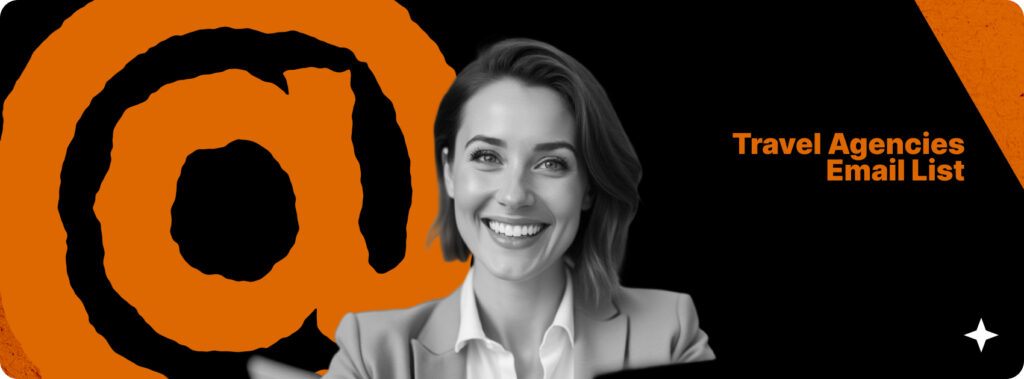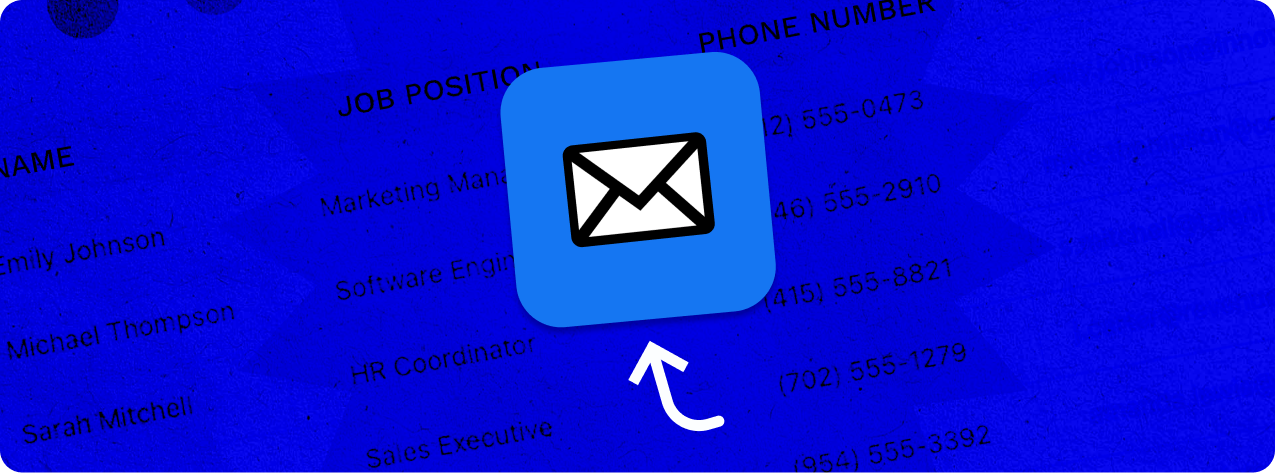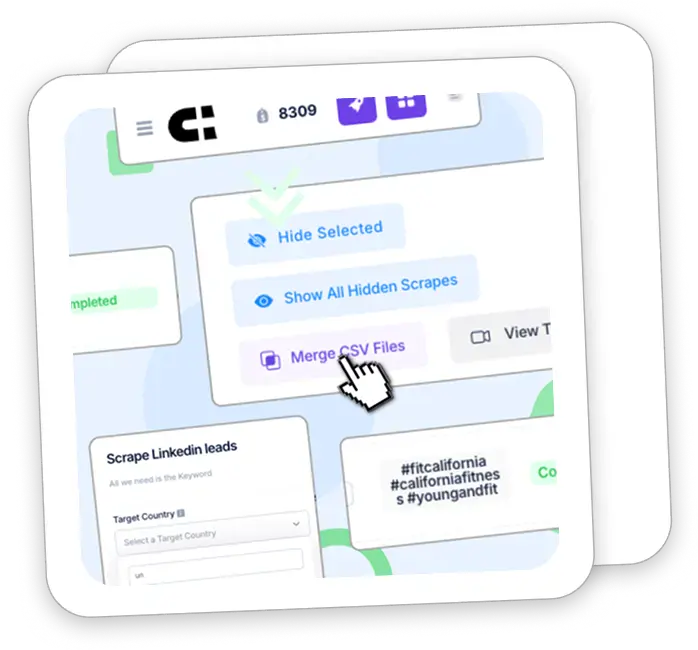Travel Agencies Email List: Where to Find Them and How to Use Them

Success in travel depends on reaching the right people fast. A targeted travel agency email list gives you that edge. Instead of paying for outdated databases, you can scrape email leads from LinkedIn, directories, and travel sites to build a fresh, accurate list in 2025.
Top Ways to Get a Fresh Travel Agents Email List
Buying email lists might seem like the fastest way to reach travel professionals, but most come with major drawbacks. Outdated information, irrelevant roles, and high bounce rates are common issues. If you want real results, the best strategy is to build or extract your own travel agents email list from trusted public sources.
Below are the most effective methods to get a fresh and usable travel agency email list in 2025.
Use travel business directories and professional platforms
Websites like Host Agency Reviews, Travel Weekly directories, and LinkedIn provide detailed business data, including agency names, locations, and decision-maker profiles. These platforms let you filter by role, company type, region, and specialty.
What to look for:
- Independent agents, agency owners, and corporate travel managers
- Filters that allow searches by location, niche (e.g. luxury, adventure, cruises)
- CRM-friendly export options or scraping capabilities
Search LinkedIn using filters and job titles
LinkedIn remains one of the most up-to-date sources for identifying travel professionals by job title, location, and agency size. With tools like LinkedIn Sales Navigator, you can segment based on specialty, tenure, and even posting activity.
Tips for LinkedIn search:
- Use titles like Travel Agent, Owner at Travel Agency, Corporate Travel Consultant, or Cruise Specialist
- Filter by geographic region or agency type
- Use connection requests to warm up leads before collecting emails
Use scraping tools like IGLeads to extract emails from public sources
For speed and scale, scraping tools are one of the most efficient ways to create a travel agency email list. Platforms like IGLeads let you extract names, roles, and emails from LinkedIn, Google Maps, and other public directories with a few clicks.
IGLeads works well for:
- Finding agents in specific cities, countries, or travel niches
- Segmenting by agency size or specialization
- Exporting clean CSV files ready for outreach
You don’t need technical skills. With IGLeads, you choose your filters, run the scrape, and receive accurate contact data you can plug straight into your CRM or email tool.
Explore travel agency websites and staff pages
For niche targeting, go directly to agency websites and check their “About” or “Team” pages. Many agencies list their key staff members, including bios and contact information. This method is slower, but ideal for hand-picking high-value leads.
Best used for:
- Targeting luxury agencies or corporate travel firms
- Verifying roles and agency focus
- Collecting context around each contact’s specialty
Buy from reputable vendors (carefully)
If time is tight, you can purchase lists from verified data providers. Look for vendors that allow filtering by role, region, and agency type. Be cautious of generic marketplaces that offer massive lists with little quality control.
Before buying, check:
- How recently the list was updated
- Whether you can filter by niche or region
- If the list is GDPR or CAN-SPAM compliant
- Claimed deliverability rate and bounce policy
Even when buying, it’s smart to clean and validate the list before sending emails. A poor-quality list can damage your sender reputation and waste your outreach efforts.
How to Use Your Travel Agency Email List Effectively
Getting a clean travel agency email list is only step one. To turn those contacts into bookings, partnerships, or demos, you need a strategy that respects their time and speaks directly to their business needs. Travel agents and agency owners receive countless emails — if yours doesn’t stand out, it won’t get opened.
Here’s how to make the most of your outreach.
Segment your list for better results
Travel agencies vary widely in size, specialty, and audience. A one-size-fits-all message won’t work. Instead, segment your list based on what makes each contact different — their niche, location, or business model — and tailor your messaging accordingly.
Examples:
- Cruise specialists may respond well to tools that bundle excursions
- Luxury agencies might prefer curated content or premium platforms
- Corporate travel planners often need automation or compliance features
Smaller segments with specific messages get better open and reply rates.
Keep your emails short, clear, and relevant
Nobody wants to read a wall of text. The best cold emails are under 100 words and feel like a real person wrote them. Skip the fluff, get to the point, and make it clear why you’re reaching out.
Simple structure to follow:
- Line 1: Personal or relevant opening (“Saw your agency specializes in adventure travel…”)
- Line 2: Why you’re reaching out (brief value prop)
- Line 3: Benefit or outcome (“Can help you cut booking time by 40%”)
- Line 4: Clear call-to-action (calendar link, reply, intro request)
Avoid attachments, jargon, or hard selling. Focus on what they’ll gain.
Use a follow-up sequence
Travel professionals are busy. One email is rarely enough. Use a short, respectful follow-up sequence to stay on their radar without being pushy.
Example 5-day sequence:
- Day 1: Personal, value-driven intro
- Day 3: Follow-up with a success story or quick stat
- Day 5: Send a helpful article or checklist
- Day 7: Ask if someone else is the right contact
- Day 10: Final soft close with no pressure
Consistent follow-ups can double your reply rate without annoying your prospects.
Lead with value, not a pitch
The fastest way to earn trust is to give something helpful before asking for anything. Sharing a resource that solves a problem shows respect and positions you as a helpful partner.
Examples of value content for travel professionals:
- Destination marketing checklists
- Travel automation tools or comparison guides
- ROI calculators for agency tools
- Industry reports on traveler behavior
Make your first impression one of value, not just sales.
Track performance and optimize
Always monitor what’s working and what’s not. Use your email tool’s analytics to track opens, replies, and bounce rates. Then tweak your subject lines, copy, or segments accordingly.
Target benchmarks:
- Open rate: 40% or higher
- Reply rate: 10% to 20% for well-targeted campaigns
- Bounce rate: Under 2%
If results are low, test different send times, CTAs, or value props. One small change can make a big difference.
Best Use Cases and Industries for Travel Email Outreach
Not all travel agencies operate the same way. Some focus on group tours, others specialize in luxury getaways, and many handle corporate travel or niche experiences. The more clearly you understand who you’re contacting, the more effective your travel agents email list will be.
Below are high-impact use cases and industry segments where targeted outreach to travel professionals can drive real results.
Software and tools for travel agents
Travel agencies constantly seek solutions that simplify booking, reduce admin time, or boost client experience. If you offer tools like CRM systems, itinerary builders, or white-label portals, email outreach can help you reach decision makers directly.
What they respond to:
- Automation platforms for quotes and bookings
- CRM systems tailored for travel workflows
- Client communication or itinerary sharing apps
Use case examples:
- Reaching boutique agencies with a mobile itinerary app
- Targeting group tour operators with bulk booking tools
- Promoting white-label platforms to independent agents
Destination marketing and DMC partnerships
If you’re representing a destination marketing organization (DMO) or a destination management company (DMC), travel agents are your gatekeepers. A clean travel agency email list helps you promote new packages, travel incentives, and local experiences.
What they respond to:
- Commissionable packages with high value
- Educational materials about lesser-known destinations
- Co-branded promotional opportunities
Use case examples:
- Inviting agents to familiarization (FAM) trips
- Sharing new itineraries to help them sell emerging destinations
- Offering travel content kits for agent marketing
Affiliate and partner programs
Many companies — from travel insurance providers to booking engines — rely on affiliate relationships with travel agencies. Outreach helps you grow your partner network faster and more strategically.
What they respond to:
- High-commission or recurring revenue models
- Simple onboarding and training support
- Tools to track earnings and client activity
Use case examples:
- Signing up independent agents for an affiliate travel insurance plan
- Offering rewards programs to agencies who hit sales milestones
- Promoting co-branded referral links or tools
B2B travel services
If you provide services to agencies — such as payment processing, financial software, legal support, or training — email is a great way to open the door.
What they respond to:
- Time-saving services that reduce overhead
- Compliance tools for international travel rules
- Upskilling and certification opportunities
Use case examples:
- Targeting small agencies with accounting software for commission tracking
- Promoting legal advisory services to agencies expanding internationally
- Inviting agency owners to virtual training events or certifications
Tips for Keeping Your Travel Agency Email List Clean and Updated
Even the best travel agency email list will lose value over time if not properly maintained. Agents switch companies, launch new ventures, or leave the industry altogether. Outdated contacts lead to bounced emails, low open rates, and poor sender reputation. If you want your outreach to stay effective, list hygiene is critical.
Here’s how to keep your list accurate, relevant, and ready for high-performing campaigns.
Re-scrape and refresh your list regularly
If you’re using tools like IGLeads, you can quickly re-run scrapes to update your data with current contact info. This is especially useful for geographic campaigns or niche verticals where changes happen frequently.
Tips:
- Refresh your list every 30 to 60 days
- Prioritize re-scrapes before major campaigns or seasonal offers
- Track changes in job titles or agency status over time
This keeps your email list aligned with real-time changes in the travel industry.
Monitor bounce rates and sender reputation
High bounce rates hurt your email deliverability. Most email platforms monitor your bounce rate, and repeated issues can land you in spam folders or get your account flagged. Catch problems early to avoid long-term damage.
Best practices:
- Clean any list with a bounce rate above 2%
- Use verification tools to validate emails before sending
- Pause underperforming segments for review
Keeping your sender reputation healthy means more emails reach real inboxes.
Remove cold and unengaged contacts
Some email addresses may still be valid but belong to people who no longer open, click, or respond. Removing these contacts helps improve overall performance and keeps your costs lower.
When to remove:
- No engagement after 3 to 4 campaigns
- Failed re-engagement attempts
- Contact no longer fits your ideal customer profile
Trimming cold leads ensures you’re only reaching people who are active and relevant.
Track job changes and agency updates
Travel professionals often move between roles or launch their own agencies. Staying aware of these changes allows you to update contact details or re-target them at their new company.
How to stay updated:
- Follow key contacts on LinkedIn to spot job changes
- Use re-scraping tools to pull updated info
- Segment contacts who’ve changed roles for new outreach campaigns
A contact’s job change is often a fresh opportunity, not a lost lead.
Respect compliance and privacy
Whether you’re emailing agents in the U.S., Europe, or beyond, your outreach needs to follow data privacy laws. Always keep records of where your contacts came from and offer a clear way to unsubscribe.
Compliance checklist:
- Never email scraped contacts marked private
- Keep opt-out lists synced across all tools
- Honor all unsubscribe requests quickly
- Avoid resending to contacts unless re-verified
Clean data isn’t just about accuracy — it also protects your reputation and keeps you on the right side of the law.
Real-World Examples of Successful Travel Agency Email Campaigns
A fresh travel agents email list is only as valuable as the results it generates. When combined with smart targeting and value-driven messaging, email outreach can unlock real partnerships, bookings, and business growth.
Below are a few real-world examples (anonymized) showing how businesses have used clean, customized travel agency email lists to drive results.
B2B tour operator filling group packages with boutique agencies
A mid-sized tour operator offering group adventure packages used a custom list of 2,000 boutique travel agencies across the U.S. They segmented by specialization (outdoor travel) and region, then launched a short email sequence offering exclusive reseller rates and ready-to-use promo materials.
Results:
- 24% open rate
- 320 replies
- 18 new agency partners signed within 30 days
Key success factors:
- Highly targeted niche (adventure travel)
- Simple offer with immediate value
- Clean, up-to-date contact data scraped from agency directories
Travel tech company offering white-label booking tools
A SaaS company offering booking software for small agencies used IGLeads to scrape contact data for independent agents across the UK and Australia. Their outreach campaign focused on ease of use and increased client retention.
Results:
- 45% open rate
- 180 demo requests
- $250K in pipeline within 60 days
Key success factors:
- Personalized messaging around agency pain points
- Short, benefits-first email format
- Accurate filtering by region and agency size
Destination marketing group promoting travel to a new region
A tourism board promoting off-season travel to a lesser-known European destination built a list of 1,500 U.S.-based travel agents who had promoted European travel in the past. Their campaign offered high-commission FAM trips and co-branded content packs.
Results:
- 38% open rate
- 520 clicks on destination resources
- 60 confirmed agents enrolled in partner program
Key success factors:
- Hyper-targeted audience with a clear incentive
- Educational and promotional value up front
- Clean list sourced from LinkedIn and industry associations
Travel insurance provider launching affiliate outreach
A B2B travel insurance platform launched an affiliate recruitment campaign to independent agents and small agencies. Using a freshly scraped list segmented by location and agency size, they promoted a high-commission affiliate model and quick onboarding.
Results:
- 20% reply rate
- 90 affiliate sign-ups
- 15 new recurring partnerships in Q1
Key success factors:
- Simple and scalable offer
- Fast, clean lead generation with IGLeads
- Follow-up sequence with educational content
What to Do Next With Your Travel Agency Email List
Now that you’ve built or sourced a clean travel agency email list, the real work starts: turning contacts into conversations. If you’re using IGLeads, you already have the advantage of fresh, recent data pulled directly from public sources. Here’s how to get the most out of it:
Segment before sending
IGLeads lets you filter by role, location, and niche while scraping — but you should still group your list before sending. Segmenting by agency size, region, or specialty helps you tailor your messaging and boosts reply rates.
Keep your emails short and specific
Even with great data, long messages won’t work. Stick to under 100 words, focus on value, and use one clear call-to-action. This is where IGLeads’ volume advantage helps — you can test multiple variations quickly because you’ll always have enough fresh contacts to work with.
Use an outreach sequence, not a one-off
No tool can guarantee a reply on the first try. Set up a 3–5 email sequence over 7–10 days. Because IGLeads can re-scrape data regularly, you won’t run out of new leads to feed into these sequences.
Monitor your metrics honestly
Vendor-filtered lists often have slightly higher deliverability. IGLeads might not match them on that front — but you can make up for it by running your leads through a verification tool before sending, then relying on the fact that your data is newer than anything prepackaged.
Good targets:
- 40%+ open rate
- 10–20% reply rate (if well-targeted)
- Bounce rate under 2% (after verification)
Keep your list fresh
This is where IGLeads shines. Unlike a static vendor list, you can re-scrape or refresh your data every month or quarter. That means when travel agents change jobs, open new agencies, or pivot specialties, your list keeps up.
Stay compliant
IGLeads only scrapes publicly available contact data, giving you a transparent starting point. From there, you need to maintain best practices: respect unsubscribes, avoid private info, and always include opt-outs.
Bottom line: If you’re tired of paying for stale lists, IGLeads gives you a way to build fresh, targeted data on your own terms. We’re the underdog compared to vendor-filtered lists on deliverability, but we win on recency, scale, and control.
Build Your Travel Agency Email List the Smart Way
Did we convince you that building your own travel agency email list with IGLeads is worth trying? With IGLeads, you don’t need coding skills or complicated setups. Just set your filters, run the scrape, and export clean, accurate contacts in minutes.
Essential Guides for Lead Generation
- B2B Lead Generation Solutions – Guide for 2025
- How to Build a High-Quality B2B Email List for Outbound Marketing
- Buy Email Lists for Marketing in 2025: Complete Guide to Business Leads
- Why Scrape Google Maps? Use Cases for Sales, Marketing & SEO
- B2C Lead Generation: The 2025 Playbook
- 15 Best Lead Generation Companies for 2025
- Best B2B email list providers in 2025
- Top Lead Generation Agencies Compared (2025)
- 18 Best B2B Lead Generation softwares in 2025
- Lead Generation Guide: Strategies & Tools for 2025
Frequently Asked Questions
A travel agency email list is a collection of contact details for travel agents and agencies, including names, roles, and verified email addresses.
You can use tools like IGLeads to extract contact data from public sources such as LinkedIn, Google Maps, and travel directories — no database purchase needed.
Yes, if the data is collected from public sources and your outreach follows GDPR, CAN-SPAM, or other regional laws. Always include an opt-out option.
Update your list every 30 to 60 days. Travel agents frequently change roles or start new agencies, so regular refreshing keeps your data accurate.
IGLeads, Apollo, and LinkedIn Sales Navigator can automate the process of finding, segmenting, and exporting contact info for travel professionals.




